Music was always one of your passions, just as you had a passionate aversion for cars. You went about on foot, or in the subway, Albini’s subway, the only truly modern work in Milan, you said. You seldom drove. And you drove badly. Above all because you were busy listening to your Mozart, or your Beethoven, your hands often leaving the wheel to conduct a particular passage. The most ethereal of the arts, music; simultaneously pure concept and pure emotion. The emotion you sought in the things you imagined. This was your way of designing. To first have an idea, a concept. To seek an emotion. Drawing was the least of your worries. You boasted of having designed directly over the phone. If the idea was clear, if it was necessary, there was no need for frills. It could be explained verbally, and in a certain sense it would draw itself. You felt like the heir to the Lombard rationalist tradition, when you said these things. Among friends and colleagues. Not at the university, because with your subtle humor you liked to say that those who know how to do things do them, while those who do not know become teachers. You didn’t teach. You did things.
In your little studio. You and your helper from the outset, the geometer Franco Montella, who with his fine surname from Campania and his professional title made you two immediately seem like the perfect odd couple of an Italian comedy. The bourgeois from Milan and the southern man of the people. Who came to the studio with a copy of the newspaper Unità under his arm, donned a smock (which turned gray over the years) and gave form to your ideas in technical drawings. Between one MS cigarette and another. An incorrigible smoker, that Montella. With whom you talked about your Inter, your favorite football team, mooching a smoke now and then. But always in the polite form, using Lei. Forty years of professional and human friendship, so profound that when he passed away you had the urge to close up shop for good. But you always addressed each other as Lei. Out of respect, not manner.
You used the more familiar form of address, tu, with your classmates and colleagues. Like Zanuso, Gardella, Castiglioni. In the 1950s you would meet up to talk things over, at the Umanitaria. Industrial design, politics, philosophy. Everything was new and extraordinary. A trip to New York by air could become an excuse for Rogers to give a lecture on the clouds seen from the airplane window. This was the start of “Italian design.” A group of friends hungry for new things who met up with the world of crafts of the outskirts of the city, which was transforming into something more. And was demanding something more of the talents from the city. It wanted to be an industry, to invent the new forms of modern life. There were people like Gismondi, Mazza, Cassina. They would drop by the studio, without even entering the courtyard, to pick up the models, the templates, directly from the studio window. While your dog snoozed in the sunlight, belly up. Milan was a city that was losing the habits of a town, but still didn’t know about those of a metropolis. Everything happened in an area of a few square kilometers. Luigi Caccia Dominioni often rode by on his bicycle, with a cheerful ring of the bell to salute Montella. You were young men in a young republic. But sensible, as was the family custom. No bohemians amongst you.
The pieces you designed had to last for years, for decades. You didn’t care about fashion. You loved the Thonet chair, in production for 150 years. You photographed everything, seeking out indispensable objects, looking at common things with an uncommon gaze. To find their essence. How many clumsy copies exist, for example, of your Nathalie bed? The matter amused you, Vico, or intrigued you. You imagined people seeing your objects in shop windows and saying to themselves: “I could have made that myself.” Which was true. But they hadn’t done it. You had thought of it first, because you understood its essence, its necessity.
